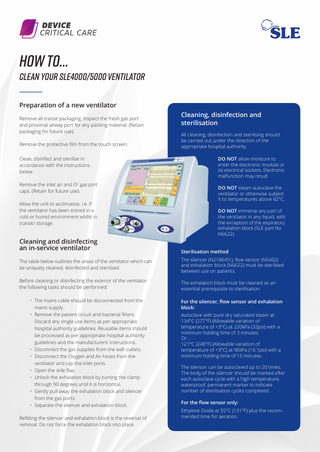SLE Limited
SLE4000 and SLE5000 Cleaning , Disinfection and Sterilisation Guide
Cleaning , Disinfection and Sterilisation Guide
2 Pages

Preview
Page 1
How To...
Clean Your SLE4000/5000 Ventilator Preparation of a new ventilator Remove all transit packaging. Inspect the fresh gas port and proximal airway port for any packing material. (Retain packaging for future use). Remove the protective film from the touch screen. Clean, disinfect and sterilise in accordance with the instructions below. Remove the inlet air and O2 gas port caps. (Retain for future use). Allow the unit to acclimatise, i.e. if the ventilator has been stored in a cold or humid environment whilst in transit/ storage.
Cleaning and disinfecting an in-service ventilator
Cleaning, disinfection and sterilisation All cleaning, disinfection and sterilising should be carried out under the direction of the appropriate hospital authority. DO NOT allow moisture to enter the electronic module or its electrical sockets. Electronic malfunction may result. DO NOT steam autoclave the ventilator or otherwise subject it to temperatures above 62°C. DO NOT immerse any part of the ventilator in any liquid, with the exception of the expiratory exhalation block (SLE part No N6622). Sterilisation method
The table below outlines the areas of the ventilator which can be uniquely cleaned, disinfected and sterilised.
The silencer (N2186/01), flow sensor (N5402) and exhalation block (N6622) must be sterilised between use on patients.
Before cleaning or disinfecting the exterior of the ventilator the following tasks should be performed:
The exhalation block must be cleaned as an essential prerequisite to sterilisation.
• The mains cable should be disconnected from the mains supply. • Remove the patient circuit and bacterial filters. Discard any single use items as per appropriate hospital authority guidelines. Reusable items should be processed as per appropriate hospital authority guidelines and the manufacturers’ instructions. • Disconnect the gas supplies from the wall outlets. • Disconnect the Oxygen and Air hoses from the ventilator and cap the inlet ports. • Open the side flap. • Unlock the exhalation block by turning the clamp through 90 degrees until it is horizontal. • Gently pull away the exhalation block and silencer from the gas ports. • Separate the silencer and exhalation block. Refitting the silencer and exhalation block is the reversal of removal. Do not force the exhalation block into place.
For the silencer, flow sensor and exhalation block: Autoclave with pure dry saturated steam at: 134°C (277°F) (Allowable variation of temperature of +3°C) at 220kPa (32psi) with a minimum holding time of 3 minutes Or... 121°C (248°F) (Allowable variation of temperature of +3°C) at 96kPa (14.1psi) with a minimum holding time of 15 minutes. The silencer can be autoclaved up to 20 times. The body of the silencer should be marked after each autoclave cycle with a high temperature, waterproof, permanent marker to indicate number of sterilisation cycles completed. For the flow sensor only: Ethylene Oxide at 55°C (131°F) plus the recommended time for aeration.
SLE HOW TO Clean Your SLE4000/5000 Ventilator
Cleaning, disinfection & sterilisation chart Warning
Clean
Disinfect
Sterilise
Ventilator
Silencer
Exhalation Block
Flow Sensor (reusable only)
Single Patient Use Flow Sensor
Warning (general): Do not insert any object (such as a needle) into the gas ports. This action will result in damage to the port. If the user believes there is a foreign object in a gas port, please refer the ventilator to qualified service personnel for inspection and repair. Note: The silencer should be autoclaved only. If the silencer is found to have visual contamination internally, discard and replace with a new silencer.
Cleaning methods
Disinfection methods
Note: Cleaning is an essential prerequisite to disinfection and sterilisation
Note: Alcohols such as 70% isopropanol have a good activity against bacteria and viruses. They should only be used after all visible surface dirt has been removed from the area to be disinfected.
Ventilator For cleaning use three clean, disposable, absorbent, non-shedding cloths. Wipe clean with the first cloth using a hand hot water/mild general purpose detergent solution (as prescribed by the appropriate hospital authority). Do not overload the cloth with liquid. Remove the water/ mild general purpose detergent solution with the second cloth using water only. Do not overload the cloth with liquid. Wipe dry with the remaining cloth. Care should be taken to ensure that the ventilator gas jets in the ports are not blocked by any debris. Warning: Ensure that the detergent solution does not enter the unit or the exhalation block gas ports on the side of the machine. Touch-screen Do not use any abrasive cleaners on the touch screen surface. Flow sensor Wash in hand hot water/mild general purpose detergent solution (as prescribed by the appropriate hospital authority). Rinse with sterile water. Warning: Do not clean the flow sensor with compressed air or water jet as this will destroy the sensor wires Exhalation block The exhalation block can be immersed and agitated in the detergent solution. Do not insert any objects into the exhalation block. Rinse the exhalation block in clean water, it must be allowed to dry thoroughly before sterilisation.
AUS
Ventilator For disinfection use two clean, disposable, absorbent, nonshedding cloths. Wipe clean with the first cloth using Alcohol (70% isopropanol). Wipe dry with the remaining cloth. Flow sensor Immersion in disinfectant recommended for use with plastic materials. Immersion times and concentrations must be in accordance with manufacturer’s instructions. Rinse with sterile water. Warning: Disinfectants containing compounds similar to PHENOL or ALKYLAMINES (Glucorrotamine) are unsuitable. Exhalation block The exhalation block can be immersed in Alcohol (70% isopropanol). The exhalation block must be allowed to dry thoroughly before sterilisation.
Please Note: SLE “How to’s...” are published as a guideline by SLE Ltd, and should only be carried out by suitably trained and qualified staff. It is strongly recommended that all operatives have read and understood the User Manual before attempting these tasks.
1300 DEVICE (338 423) [email protected] www.device.com.au
NZ
0508 DEVICE (338 423) [email protected] www.device.co.nz